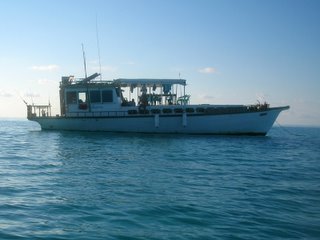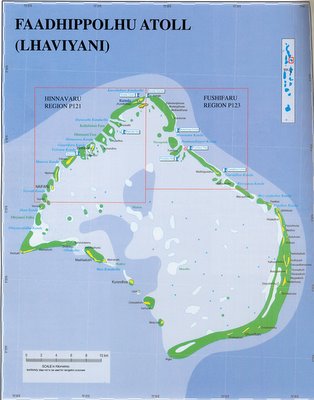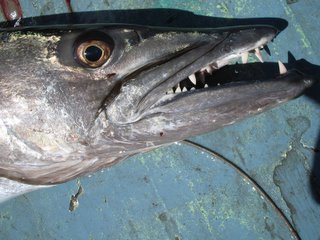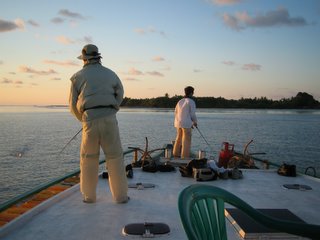CAUTION: Long Post
Day 1:
 To most of this Coho team, it would be a much anticipated return to our fishing paradise. However, for a few of us, this would be a first. William (Team Guide), Michael (Owner of Coho Fishing Tackle), Gerard, Amin, Lee and I, have made this 2102 mile (3382 km) journey quite a few times. However, for Andy, Mah, Gan and Moses, it was to be their virgin fishing safari to the Maldives.
To most of this Coho team, it would be a much anticipated return to our fishing paradise. However, for a few of us, this would be a first. William (Team Guide), Michael (Owner of Coho Fishing Tackle), Gerard, Amin, Lee and I, have made this 2102 mile (3382 km) journey quite a few times. However, for Andy, Mah, Gan and Moses, it was to be their virgin fishing safari to the Maldives.With a recent trip report bearing less than positive news of strong winds and a mediocre result, the team nonetheless carried high hopes of trading blows with some of the '‘Gangsters of the Surf', the Giant Trevally (Caranx ignobilis,) and a chance to spot and, hopefully, land a few '‘Ghosts of the Flats'’, the Bonefish (Albula vulpes).
 Armed to the teeth and toting rod tubes bearing a brand name like 'Bazooka'’, it was no wonder we were greeted with apprehensive stares from the airport personnel. With no real incidents, we arrived slightly before midnight to our awaiting host, Mohammed, who promptly led us to a Dhoni, or a boat taxi, that would send us to our Safari Dhoni, the Mashibaru.
Armed to the teeth and toting rod tubes bearing a brand name like 'Bazooka'’, it was no wonder we were greeted with apprehensive stares from the airport personnel. With no real incidents, we arrived slightly before midnight to our awaiting host, Mohammed, who promptly led us to a Dhoni, or a boat taxi, that would send us to our Safari Dhoni, the Mashibaru.Once aboard, the team went about arranging their gears and their quarters before settling down for the night.
The sun rises early in this part of the world; 5.30am to be precise. The crew, captained by Ibrahim, had the boat leaving the harbour even before the whole team had awoken. Roused from their slumber by the steady drone of the engine, one by one, the team members began preparing for what was to be a long 8 hour journey to our fishing ground, Faadhippolhu Atoll, formerly known as, Lhaviyani Atoll.

2 trolling rods, one paired with an Accurate; the other, a Penn International 30, trailed a Halco and a Rapala CD18 respectively. With the lures out, the team began to set up the fly arsenal that included rods from Sage and Winston to reels from Ross and Abel. Ranging from 6-weight to 10-weight rods, there were enough rods to arm our team three times over.
Over the din of jovial bantering came Ibrahim'’s voice: "On!" In a split second, everyone was at battle-stations at the stern of the boat. Both the Penn and the Accurate had line peeling in a blur. Gerard was on the 'fighting chair' while Mah took the rod standing. It seemed like a double hook up. Gerard started pumping the fish in an attempt to gain line. The boat was slowed and both rods started to put line back on the spool. However, the two lines had intertwined together. With one rod kept in tension, the other rod was passed over and under to clear the twist. When both lines were separated, it soon became clear that the rod Mah was holding that had the hookup. Wanting to return the rod back to its rightful owner, Mah handed it to Amin who proceeded to wind back the already rapidly tiring fish.

A white dot began to grow as it got closer and soon the form of a huge Great Barracuda (Sphyraena barracuda)materialized in the clear waters below us.

It was a monstrosity of a fish, tipping the scales at over 20kg.
Would this herald the beginning of a fantastic trip? No one dared to say but I believe that in everyone's heart, a little spark was starting to ignite a small fire that would burn harder and brighter as the days went by.
 It was arranged that we would have a short session on the island of Maduvvari. As Ibrahim found us a good spot to weigh anchor, the team got to work gearing up with eager anticipation. It was a scene much akin to a squad preparing for a mission, with the battle-hardened squad leaders going about their tasks with a certain nonchalant proficiency. While the new recruits fumbled with unfamiliar gear and displaying expressions of hope, apprehension and excitement. Mind you that these are not inexperienced fly-fishermen. But with the immense array of equipment and gear, we were spoilt for choice as to what was needed and what was good to have. Vests, Camelbak water packs, Stripping baskets, Boga-grips, rods and reels. We had to balance mobility with functionality.
It was arranged that we would have a short session on the island of Maduvvari. As Ibrahim found us a good spot to weigh anchor, the team got to work gearing up with eager anticipation. It was a scene much akin to a squad preparing for a mission, with the battle-hardened squad leaders going about their tasks with a certain nonchalant proficiency. While the new recruits fumbled with unfamiliar gear and displaying expressions of hope, apprehension and excitement. Mind you that these are not inexperienced fly-fishermen. But with the immense array of equipment and gear, we were spoilt for choice as to what was needed and what was good to have. Vests, Camelbak water packs, Stripping baskets, Boga-grips, rods and reels. We had to balance mobility with functionality.The small, green dinghy was powered by a 4hp Yamaha outboard. The first wave brought 4 to the beach with the other 4 coming in the second wave. As Michael was down with fever, William had volunteered to stay onboard to accompany him. My Motorola Talkabout squawked and I heard Michael asking us to bring some fish back for dinner. Gerard, Mah and I, headed to the right of the island while the rest of the group either hung around the landing point or proceeded left.
Maduvvari is a small island that you can fish round in about 45 mins. The leeward side of the island has vegetation right to the edge of the beach with pockets of flats with good back cast space.
Treading lightly in the water with Mah about 20m ahead of me, I made blind casts into the brown coral patches with my new nameless fly, a recipe I had concocted on the boat while on the way here. With a very slow strip, I worked my fly back towards me, bouncing it over the corals beneath. With the leader hanging out and the fly still in the water, I turned to make my way after Mah. Just as the fly started to move, I felt the fly line tug at my fingers and my rod started to flex a little. I raised the rod and slowly pulled the line in and "“Zzzzzziiiiiiiip!…"” I guided the remaining fly line back to the rod and then let the reel take over. Palming lightly, I tried to turn the fish and managed to disorient it enough to make it swim back towards me.
With less than 10m, the fish took one look at me and went ballistic, peeling line off my spool at a mind boggling speed. I was beginning to worry about my line getting cut off amidst the corals beneath so I applied as much pressure as I dared and once again turned the fish shore-wards.

Reeling in as fast as the fish was swimming in, I was soon to my leader again and I caught my first glimpse of my piscatorial adversary; a nice table-size Yellowlip Emperor (Lethrinus xanthochilus).
 Barely 15mins after making landfall, and I already had the fish for dinner. The only problem was how to lug the fish around. I had only a small Camelbak backpack with hardly any space for anything else. So, I lipped the fish with my Boga-grip and hung it off my belt. I had to be extra alert, in case, an over-zealous shark tried to cash in on a free lunch and my bum, of course.
Barely 15mins after making landfall, and I already had the fish for dinner. The only problem was how to lug the fish around. I had only a small Camelbak backpack with hardly any space for anything else. So, I lipped the fish with my Boga-grip and hung it off my belt. I had to be extra alert, in case, an over-zealous shark tried to cash in on a free lunch and my bum, of course.Meanwhile, Mah, while watching my tussle with the emperor got a hit and started his own little skirmish. However, it was to be a short affair as he suddenly felt the line go limp. The fish had thrown the hook.
About 5pm, we radioed the boat to pick us up and we made way for Kurendhoo, where we would be spending the night. Ibrahim, the captain and, Hussain and Wahab, the deckhands are natives of Kurendhoo while Susantha, the cook, is a Sri Lankan. There we would have dinner and have our freshwater topped up for the next day'’s excursion.
On board, we had the first of many updates; Gerard had hooked a humongous Titan Triggerfish (Balistoides viridescens) on a crab pattern. Gan scored a honeycomb grouper (Epinephelus merra) and a Banded Needlefish (Strongylura leiura) on a Crazy Charlie. William and Michael had been busy themselves, accounting for a few groupers and triggerfishes from bottom fishing.
Exchanging fly rods for some light tackle trolling; William and Gan began trolling from the stern of the Mashibaru.

Over at the bow of the boat, Mah and Gerard had a go at popping. On the approach to the coral reef on the edge of Kurendhoo , Mah's popper was engulfed in a wild splash and line started to pull off the spool. Using only a light popping rod and a small popper, Mah had a real fight in his hand.
Making his way gingerly to the stern while trying to maintain pressure on the fish, slowly but surely, he recovered line. Not giving in easily, the fish made a few more dashes back towards the coral heads. With slow and steady strokes, Mah finally coaxes a beautiful Green Jobfish (Aprion virescens) back to the waiting gaff.
When we got going again, the trolling duo turned up the heat with a double hookup. Gan wrestled a nice Black Grouper while William easily bullied a Yellowledge Lyretail (Variola louti,)

Along the outer walls of Kurendhoo harbour, were reminders of the power of the recent tsunami. Although spared largely due to the almost vertical nature of its geography, Maldives, nonetheless, felt Nature's fury. The 2 concrete walls, that was the entrance to the harbour, were all but washed away.

The outer wall had caved-in in a few areas and there was a deep undercut where the wall met the rocks. It was told to us that funding will be given to help rebuild the harbour walls.
Guiding her gently through the harbour mouth, Ibrahim found Mashibaru her berth and brought her to a stop.
At sunset, baitfish congregation in the harbour was at its greatest. A blanket of brown beneath the water surface, it would suddenly come to life in a magical dance as predators rounded them up from below. What sounded like sizzling oil was actually baitfish in the millions jumping out of the water, trying to escape from the jaws of death. From above, this struggle of life and death seemed like a magnificently choreographed musical fountain, swaying right one moment and then, left the next. And so, with the last light fading into the horizon, the enthralling performance ended as the school made their way out of the harbour. This amazing scene was to repeat itself over the next couple of nights we were anchored here.




